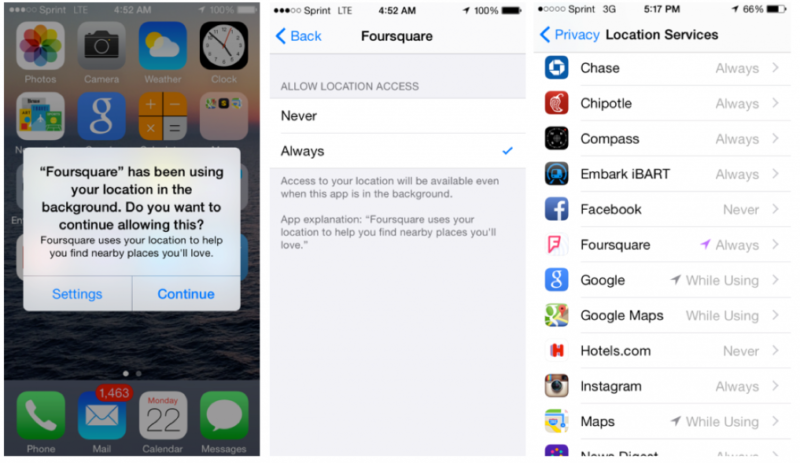Will Apple’s “Location Warnings” Be Educational Or Scary?
Last week the subscription-only The Information wrote about Apple’s new “location warnings” and its potential impact on developers. This is something I explored from a user perspective on my personal blog last month. Previously Apple enabled users to turn location off or on. Now there are three potential settings: “always,” “never” or “while using the […]
Last week the subscription-only The Information wrote about Apple’s new “location warnings” and its potential impact on developers. This is something I explored from a user perspective on my personal blog last month.
Previously Apple enabled users to turn location off or on. Now there are three potential settings: “always,” “never” or “while using the app.” Developers are not compelled to offer “while using” however.
The really significant new element in iOS are “location warnings,” as The Information calls them, or location notifications. Apple sends a pop-up message to users that app X or Y is using location in the background and invites users to opt-in or change settings. Upon clicking “settings,” users are taken directly into the location-services area, showing all installed apps and their location settings.
As indicated, many apps offer a binary choice: “never” or “always.” But some offer the “while using” option. My personal response the first time I saw this was basically to shut down location for all apps but the few that truly require it. I also turned everything to “while using” if that option was present.
It’s interesting that developers get to make an argument for why they should get access to location. In the screenshot above Foursquare says, for example, “Foursquare users your location to help you find nearby places you’ll love.”
The Information article points out that Apple is treating its own apps differently than those of third parties:
Apple isn’t providing the same level of warning around it own apps. For instance, when Google Maps is using location data without being open, a banner flashes: “Google maps is using your location.” For Apple Maps, the message is friendlier: “Touch to return to navigation.”
The same controls exist and apply to Apple Maps as with Google Maps. Users can allow Apple Maps to monitor location in the background, never provide access or enable access only “while using the app.”
The suggestion in The Information article is that Apple has introduced a subtle location-bias in favor of its own apps (really just Maps). I asked Apple to comment on the alleged discrepancy and the company thus far has not responded.
The Information article doesn’t go into why location is desired by publishers and developers, even where the app in question seems to have nothing to do with location services. Location on mobile devices is the new cookie.
By watching location history marketers and developers are able to gain valuable information about their audiences. My behavior in the world (where I go, what stores and places I visit) reveals a lot about who I am. This can be used for audience discovery and segmentation and for customization and personalization.
Location is often passed to third party ad networks for audience or real-time location targeting and retargeting.
Most consumers have a complicated relationship to location and location tracking. When its purpose is clear they’re typically willing to opt-in. However a majority of consumers don’t want third parties monitoring their movements as a general matter. This idea is supported by many surveys.
All of the parties in the mobile marketing ecosystem routinely say that any tracking/targeting based on location or location history is done in an anonymous, privacy compliant way. But most users don’t have any idea about how all this works.
Accordingly, when iOS 8 users start to see the Apple notification that such-and-such app is using location in the background, I would predict that many will shut down location — just as I reacted. However offering a “while using” option could mitigate this reflexive reaction.
It would make sense for developers to get ahead of this issue. I suspect that eventually Apple and/or the FTC will compel developers and publishers to offer the “while using” option. I also suspect that this kind of notification system will come to Android as well, which is less transparent to users regarding use of location.
Although it may create short-term headaches for developers, it’s a net positive that Apple is starting to educate users about location and get them to affirmatively opt-in. Among other things, this will ultimately insulate the industry against claims of “surveillance” and unauthorized “tracking.” It’s also the right thing to do.
Opinions expressed in this article are those of the guest author and not necessarily MarTech. Staff authors are listed here.
Related stories
New on MarTech


